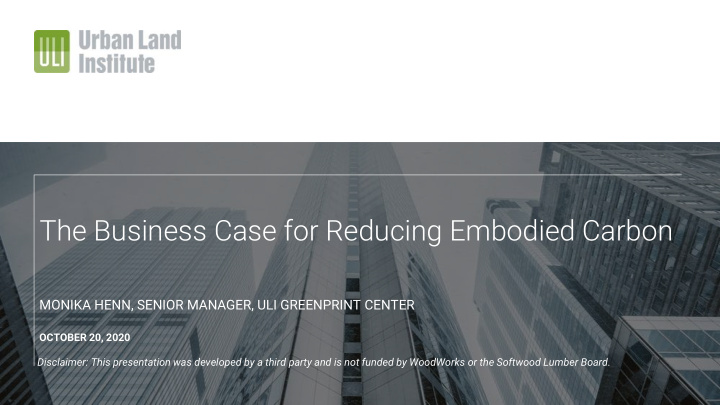



The Business Case for Reducing Embodied Carbon MONIKA HENN, SENIOR MANAGER, ULI GREENPRINT CENTER OCTOBER 20, 2020 Disclaimer: This presentation was developed by a third party and is not funded by WoodWorks or the Softwood Lumber Board.
Introduction Why Embodied Carbon? 1
Regulations are Coming ▪ Buy Clean California mandates EPDs for materials used in state-funded building projects ▪ Bay Area Low-Carbon Concrete Codes ▪ Vancouver’s Zero Emissions Buildings policy sets the city on track to reduce embodied carbon by 40% by 2030 ▪ Netherlands Circularity Goal to be 100% circular by 2030 2
Green Building Certifications and Reporting Structures Increasingly Look at Materials 3
No Incremental Cost for Lower-Carbon Materials 4
Interest from Communities and Tenants “Our goals are to get ahead of trends and be a leader, because people who lead on this now will be able to do low carbon much more cost- effectively down the line. And for new projects in cities like San Francisco and Washington, D.C., it’s easier to get approval for projects that represent the city’s values.” - Andy Bush, Morgan Creek Ventures 5
Market Challenges What are the barriers to reducing embodied carbon? ▪ Market for low-embodied-carbon materials and knowledgeable contractors is still developing ▪ Limited data for EPDs and LCAs not always available 6
7
Project Profiles 8
Carbon12 – Portland, OR Kaiser Group and Path Architecture ▪ 8 story multifamily building completed in 2018 ▪ Constructing with steel core, glulam beams and columns, and CLT floors ▪ $2.50/ft 2 more than all concrete in material costs ▪ Construction timeline cut from 19 weeks to 8 weeks ▪ Replicating the process estimated to cost 20- 25% less ▪ Avoided 223 metric tons of CO 2 e
Circl – Amsterdam, NL ABN AMRO ▪ 30,000 ft 2 pavilion completed in 2017 ▪ Incorporated circular principles by reducing material waste and designing for reuse ▪ Large local Dutch larch CLT beams were used to replace traditional concrete structure ▪ Leftover wood from beam construction makes up parts of the interior ▪ Flooring reclaimed hardwood from local buildings
Nishi Building – Canberra, Australia Molonglo ▪ Mixed-use development with 233,653 ft 2 of multifamily space and 524,442 ft 2 of commercial space completed in 2014 ▪ Sustainable materials were a priority ▪ 25 miles (40 km) of sustainably harvested timber from regional blackbutt gum trees ▪ Reclaimed timber — the entryway alone used more than 2,000 pieces of reclaimed timber ▪ Investments made to indicate value to tenant in hopes of creating happier and more valuable tenants ▪ Recently sold to office REIT for $256M “If you plan for it, the economics works out.” - Nikos Kalogeropoulos, Molonglo
uli. li.org rg/embodiedcarbon 12
Monika Henn Manager, ULI Greenprint Center monika.henn@uli.org
Recommend
More recommend